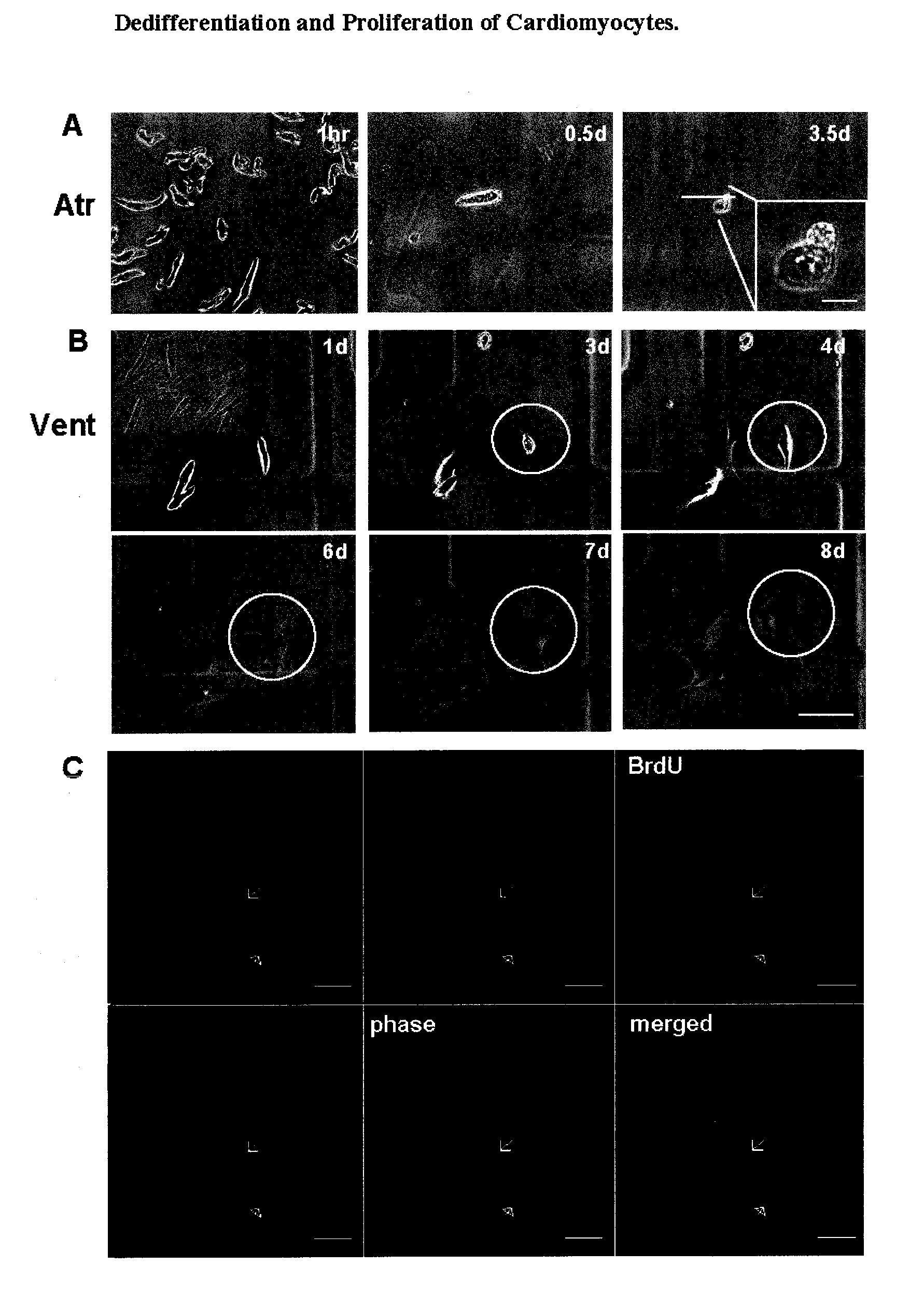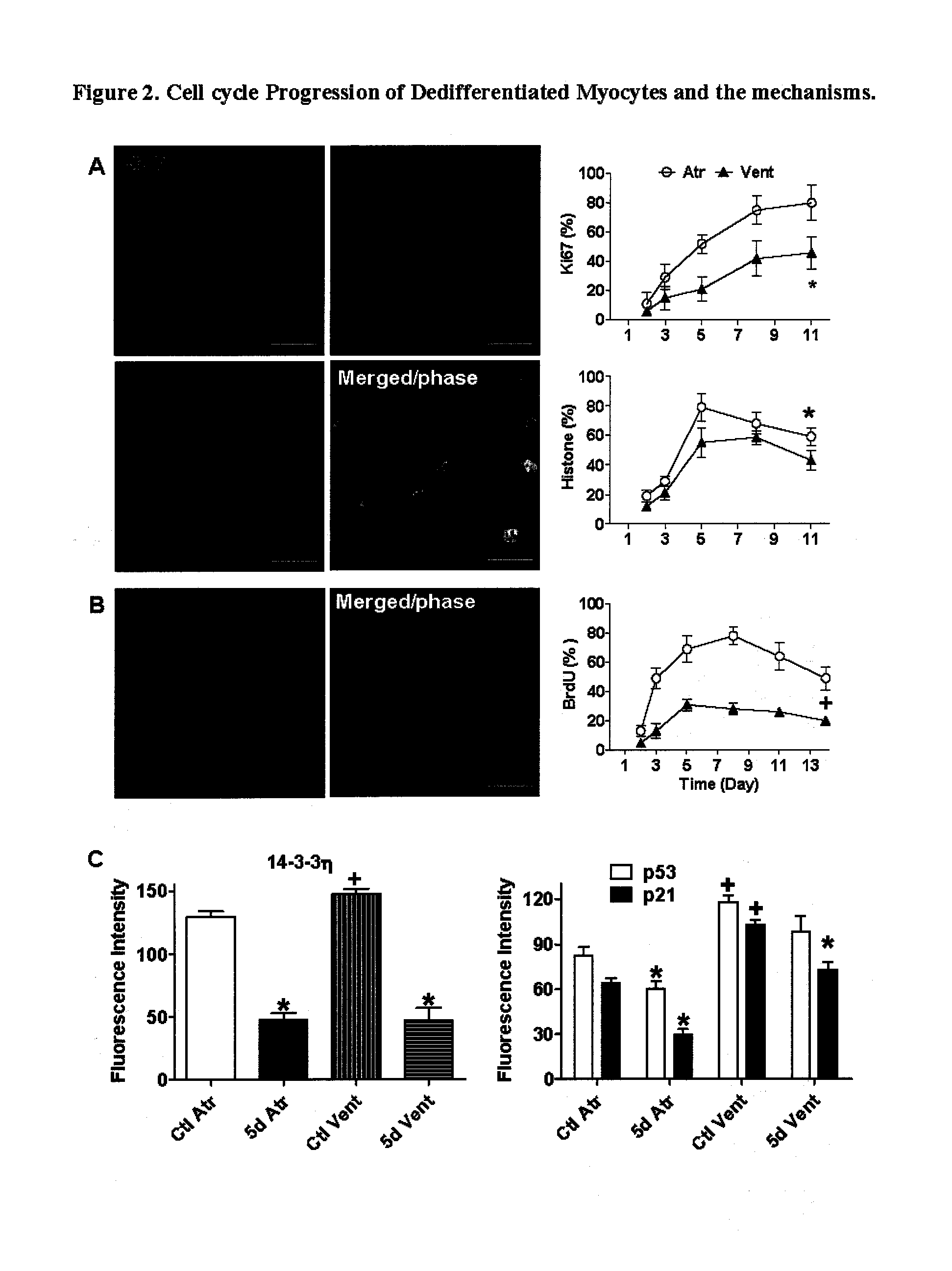Dedifferentiation of adult mammalian cardiomyocytes into cardiac stem cells
a technology of stem cells and adult mammalian cardiomyocytes, which is applied in the field of stem cells and stemlike cells, can solve the problems of little knowledge regarding the sources of cardiac stem cells, and achieve the effect of increasing the proportion of myocytes
- Summary
- Abstract
- Description
- Claims
- Application Information
AI Technical Summary
Benefits of technology
Problems solved by technology
Method used
Image
Examples
example 1
Dedifferentiated Cardiomyocytes Re-Enter Cell Cycle and Proliferate
[0029]We purified enzymatically-separated cardiomyocytes from hearts of adult rats, guinea pigs or mice using multiple differential centrifugation and Percoll gradient separation steps. Tests of morphology (FIG. 1), immunoreactivity (FIG. S1A), and RT-PCR (FIG. 3, FIG. S5) confirmed the purity of the isolated cardiomyocytes. Visually, the primary cells look homogeneously large and striated despite that atrial myocytes have variable shapes when plated to culture; more importantly, there is no detectable expression of proteins or transcripts characteristic of fibroblasts, endothelial cells or stem cells. To track individual cells in culture, atrial and ventricular myocytes were cultured at low density in grid-culture dishes or on coverslips. Shortly after plating, myocytes dedifferentiated, losing striations, rounding up and, often, beating spontaneously. Immunocytochemical studies demonstrated that after 3 days of cul...
example 2
Myocyte-Derived Cells Exhibit Cardiac Stem Cell Markers
[0033]Myocytes cultured in normal density become confluent after 1-2 weeks (FIG. S4A) and thereafter clusters of loosely-adherent phase-bright round cells emerged above the monolayer of dedifferentiated / proliferating cells (FIG. 3). These cells, seemed to be heterogenous in size (FIG. S4B), can be harvested by gently pipetting without trypsinization and are referred to as myocyte-derived cells (MDC).
[0034]Dedifferentiation, e.g., in pigment cells, has been demonstrated to contribute to stem cells and tissue regeneration (Real et al., 2006). We asked if MDC that is distinct from cardiomyocytes in morphology and electrophysiology, have any characteristics of cardiac stem cells (Smith et al., 2007; Boyle et al., 2006). By direct and indirect fluorescent immunostaining, we found that rat MDC do indeed express stem cell markers c-kit and CD34, but little or weak, if any, sca-1 or CD90 (data not shown); 61±19.7% freshly harvested MDC ...
example 3
Myocyte-Derived Cells Re-Differentiate
[0036]MDC self-organized into spheres 3-5 days after the cluster cells became more confluent. There were 0˜4 spheres in each well of a 6-well culture plate, depending on the condition of cells. MDC spheres either loosely adhered to the culture layer or became suspended in medium, and show slow spontaneous activity within 2-5 days of sphere stage (FIG. S4C. The semi-adherent spheres could be harvested by gentle pipetting. Semi-adherent or suspending spheres flattened onto the bottom when seeded into fibronectin-coated plates, and gave rise to cells off the spheres, which eventually stopped beating while turning into monolayer cells (FIG. 4A). Moreover, myocyte cultures could provide 3˜4 harvests of MDC or spheres. New daughter cells emerged again always around the area where previous MDC were produced.
[0037]In the spheres, most cells were positive for α-MHC, connexin 43 (Cx43), and CD31 immunostaining, and some positive for c-kit. Some cells off ...
PUM
 Login to View More
Login to View More Abstract
Description
Claims
Application Information
 Login to View More
Login to View More - R&D
- Intellectual Property
- Life Sciences
- Materials
- Tech Scout
- Unparalleled Data Quality
- Higher Quality Content
- 60% Fewer Hallucinations
Browse by: Latest US Patents, China's latest patents, Technical Efficacy Thesaurus, Application Domain, Technology Topic, Popular Technical Reports.
© 2025 PatSnap. All rights reserved.Legal|Privacy policy|Modern Slavery Act Transparency Statement|Sitemap|About US| Contact US: help@patsnap.com



